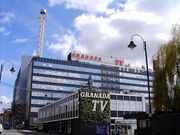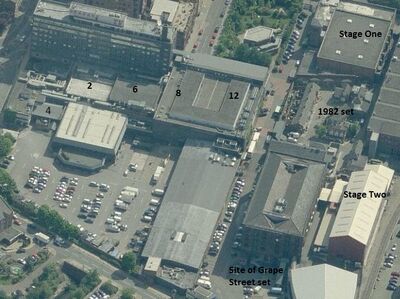
The Quay Street complex. The red lettering was removed from the building in 2010
The Quay Street Studios of Granada Television in Manchester were the home to Coronation Street for the first fifty-three years of the programme’s production. The studio complex opened for its first transmission on 3rd May 1956 when Granada broadcast to the country for the first time. Despite the fact that it was thirty years since a daily television service had started in the UK, these were the first purpose-built television studios in the country as those operated by the BBC, Associated Rediffusion, ATV and ABC in the North and Midlands were in buildings converted from other uses. For instance, ABC’s Manchester studios were in a converted cinema on School Lane in Didsbury.
All of the studios in the complex were given even numbers as Granada Chairman Sidney Bernstein felt that this would give an impression that there were many more than actually existed. The Manchester complex eventually had studios 2,4,6,8 and 12 with London hosting Studio 10 in the old Chelsea Palace theatre which opened in 1957 and housed productions where the actors or contributors would not, or could not, travel to Manchester. Future Coronation Street producer Bill Podmore began his Granada career in this studio which hosted programmes such as The Army Game and Chelsea at Nine. The studio closed in the mid-1960s with all production moving to Manchester with the exception, for some years anyway, of the World in Action team who preferred to maintain an editorial distance from their bosses in the north.
Back in Manchester, the five remaining studios did not all come on line in 1956 but came into use as the Granada Television operation expanded, with Studio 12 opening in 1958 which was for two years the largest television studio in the UK. Along with the expansion of the studios, the overall complex increased its other facilities with the tower block (picture above) opening in 1961. This addition provided purpose-built rehearal rooms and, continuing Bernstein's illusion of size, were named "studios" but with odd numbers. For many years, Coronation Street was allocated Studio 7 which had two side rooms, one of which was a green room for the cast and housed "Dear Quatermass", the ivy plant that had been given as a present by the departing Noel Dyson in September 1961 and which still survives to this day, tended by superstitious actors who believe that if the plant dies, the programme will itself end.
The Manchester recording studios' space was as follows:
- Studio 2: measuring some 43 x 75 feet, this was the second smallest of the Manchester studios and is famous for hosting the live transmission of Episode 1 of Coronation Street on 9th December 1960. Space for sets was therefore extremely cramped and according to several memories the wall of the set of the Rovers could be almost immediately adjacent to that of the Corner Shop. The erection of the street set in the studio meant that the number of the other sets in that episode would be extremely restricted and even then, the entirety of the terrace couldn’t be shown. This studio was later used for the local news programme Granada Reports and the last transmission of that programme came from this studio on 22nd March 2013.
- Studio 4: Dimensions not known - this studio was a small presentation and continuity studio and is best known for being the studio from where The Beatles made their television debut on 17th October 1962 on the regional programme People and Places. It was later converted into a reception area.
- Studio 6: measuring some 59 x 75 feet, this was the studio within the main complex that hosted the recording of a majority of Coronation Street episodes from the 1960s to 1990. In later years it was used for the recording of the Jeremy Kyle Show, The Heaven and Earth Show and The Royle Family.
- Studio 8: measuring some 69 x 75 feet, this was also a studio that hosted a recording session of many episodes of the programme. Later programmes recorded here included University Challenge, Mastermind, A Question of Sport, Soapstar Superchef and Countdown.
- Studio 12: measuring 105 x 75 feet, this large studio was rarely used for the recording of Coronation Street, being more suitable for variety and entertainment shows. As early as 1972 after the success of the filmed series Country Matters, Sidney Bernstein asked if the studio was now a large white elephant to the company but its remained in use until 2011 hosting shows such as Stars in Their Eyes, The Price is Right and Soapstar Superstar. One major connection between this studio and Coronation Street was that it was used to host the annual combined Christmas and anniversary party for Coronation Street actors and production staff in 1970 when H.V. Kershaw wanted to find larger premises to hold the party in and not have to disappoint some people with a lack of invitation which had been the case in previous years.
Further expansions

The Granada complex from the air with studios and sets annotated
From 1968 onwards, further expansions of the Granada site took place, some of which involved Coronation Street:
In 1968, Granada rented a railway yard to erect the programme's Grape Street set which was in use until 1982 and then demolished in June of that year. In its place, the programme’s second set was built on the other side of a bonded warehouse from the original set. The warehouse itself was used for various purposes including a sets and costume store and on its southern side the Baker Street set for The Adventures of Sherlock Holmes was built. This expansion eventually involved Granada purchasing Grape Street itself from Manchester City Council and absorbing it into the Granada site.
In 1988 the Granada Studios Tour was opened which allowed the public to tour the 1982 set on non-filming days. The site of the 1968 set was the entrance to the tour, built to look like a New York street.
During 1990, it became apparent to Granada management that Coronation Street was acting as a block on other productions in the main complex as it occupied a studio for two whole days for technical runs and recordings which could be better put to other uses. With the recent increase to three episodes a week, the company invested in the Stage One complex, a converted building adjoining the main one which had previously been used for hosting and transmitting ten-pin bowling. The programme moved here full time in that year, later also opening a second set of studios named Stage Two on the site of the now-demolished Baker Street set and expanding the outdoor set in 1999 to include buildings on the fictional Victoria Street.
Closure
On 16th December 2010, it was announced that ITV’s operations at Quay Street would close and move to the new Media City studios site on Salford Quays where the BBC had also opened up an operation with many formerly-based London programmes also transferring. The move took a few years to accomplish with, the last recorded programme at Quay Street, aside from Granada Reports, being an edition of University Challenge made in studio 8 on 17th February 2013. The intention was that Coronation Street would also move to its new purpose-built studios at Media City at the same time but in the end it remained at Quay Street for the remainder of the year. The last exterior shot for the programme on the Quay Street site was for Episode 8338 (7th March 2014) of Peter Barlow in Rosamund Street and the last interior shot, recorded at the end of the same day - 20th December 2013 - was of Eileen, Todd and Jason Grimshaw in the back room of 11 Coronation Street from Episode 8333 (28th February 2014), however the last edition to be shot entirely at Quay Street was Episode 8328 (21st February 2014).
In September 2013 it was announced that developer Allied London had acquired the site for a reported £26.5m and taken a 5 year lease on the studios and associated buildings while they considered their redevelopment plans. The 1982 set was opened to the public on 5th April 2014, initially for six months but now extended until the end of 2015. The four remaining studios within the main complex are now being hired out for events or filming, marketed as the “Old Granada Studios”.







